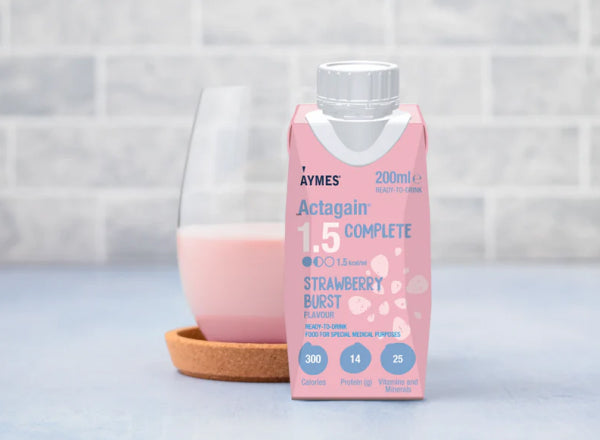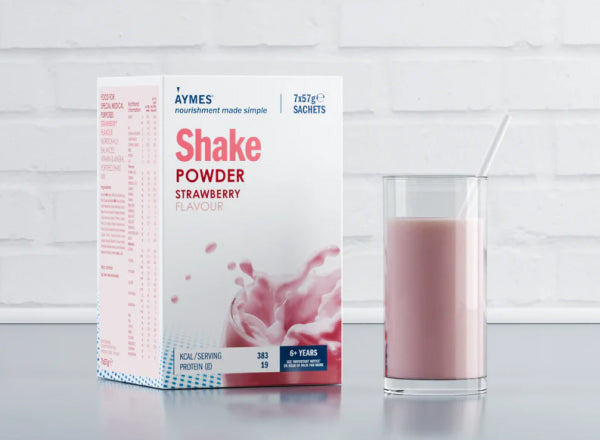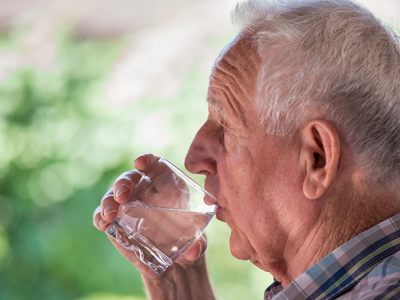
This information was written by Harriet Smith, Registered Dietitian, in July 2019. It was peer-reviewed by Registered Dietitians: Magdalena Kot, Sasha Dunn, Gemma Fry, Aisling Pigott-Jones and Clare Thronton-Wood.
Section 1
Background information on Malnutrition and Frailty
Malnutrition
Malnutrition is a major clinical and public health problem in the UK.1
Key Statistics2
- Over 3 million people are malnourished
- 93% live in the community
- 1.3 million are over the age of 65
- One third (32%) of people aged 65 years or over are at risk of malnutrition on admission to hospital
Malnutrition, in all its forms, describes undernutrition (wasting, stunting, underweight), overnutrition (overweight and obesity) and micronutrient imbalances.
There is no universally accepted definition for malnutrition, however the following is commonly used:
“A state of nutrition in which a deficiency or excess (or imbalance) of energy, protein and other nutrients causes measurable adverse effects on tissue/body form, body function and clinical outcome” (Elia, 2003).3
This online article focuses on undernutrition, which will be referred to as ‘malnutrition’.
Frailty
The term ‘frailty’ is used more loosely to describe a range of conditions and symptoms such as general debility, sarcopenia (loss of muscle mass and function), weight loss, increased vulnerability and cognitive impairment.4
It can occur as a result of certain diseases and medical conditions.5 Frailty is also linked to the ageing process and mostly affects elderly people.
NHS England describe frailty as a loss of resilience, where people don’t bounce back as quickly after stresses such as infection, bereavement or changes in environment due to a gradual loss of in-built reserves.6
This means that frail people are at higher risk of adverse outcomes such as falls, delirium, admission to hospital, or the need for long-term care.
It’s important to note that frailty varies in severity and can get better or worse. It is not an inevitable part of ageing, and not all older people will develop frailty.
Key Statistics:
- Malnourished individuals are almost 4 times more likely to be frail7
- Half of people who are frail are likely to be malnourished8
Signs and Symptoms
Malnutrition
Common signs and symptoms of malnutrition include:9
- Loss of appetite
- Weight loss – i.e. loose clothing and jewellery
- Tiredness, loss of energy
- Difficulty concentrating
- Changes in mood such as anxiety and depression
- Delayed wound healing
- General sense of weakness
Frailty
Common signs and symptoms of frailty include:10
- Increased falls
- Reduced walking speed
- Weight loss
- Memory and cognitive impairments
- Sudden and increased physical disability
- Delirium
Diagnostic and Screening Criteria
Malnutrition
A person is classified as malnourished if they meet a set of criteria which often includes:
- A low Body Mass Index (BMI)
- Significant and unintentional weight loss over a defined period of time
- Reduced nutritional intake over a defined period of time
Nutritional screening for malnutrition is recommended in NICE clinical guideline 32, recommendation 1.2 in the following situations:11
All hospital inpatients on admission and outpatients at their first clinic appointment
- Admissions to care homes and when there is clinical concern
- During initial registration with a GP surgery and when there is clinical concern
Additionally, ESPEN Guidelines on Clinical Nutrition and Hydration in Geriatrics state in
Recommendation 5 that: “All older persons —independent of specific diagnosis and including overweight and obese persons—shall routinely be screened for malnutrition with a validated tool in order to identify those with (risk of) malnutrition.”12
Screening is a rapid and simple way to detect those with or at risk of malnutrition, so that suitable action plans can be implemented.13
Commonly used screening tools include:
- Malnutrition Universal Screening Tool (MUST)
- Malnutrition Screening Tool
- Nutritional Risk Screening - 2002
- Mini Nutritional Assessment
- NUTRISCORE (Oncology Patients)
- The Short Nutritional Assessment Questionnaire
The MUST screening tool (see figure 1) is the most frequently used in the UK. It is a five-step tool which is suitable for screening adults across all care settings. It is used to detect those who are malnourished, at risk of malnutrition or obese.
The five steps are as follows:
- Measure height and weight to determine Body Mass Index (BMI)
- Calculate percentage of unplanned weight loss in the past 3-6 months
- Establish acute disease effect and score
- Add scores together to obtain an overall score for risk of malnutrition
- Use management guidelines and/or local policy to establish a treatment plan

Figure 1: Malnutrition Universal Screening Tool (MUST)
Whilst screening tools do exist, recent evidence from BAPEN Nutritional Screening Surveys,14 conducted between 2007 and 2011, and the recent HIQA Hospital Nutrition and Hydration Report (2017)15 suggest that nutritional screening is still not being fully implemented. Failure to screen or inaccurate scoring could lead to missed dietetic or nutritional intervention which could have serious consequences for patients.
Therefore, it’s important that all staff involved in nutrition-risk screening are suitably trained to meet required standards for their organisation. The Care Quality Commission (CQC) is the independent regulator of health and social care in England. Regulation 14 relates to meeting nutrition and hydration needs of service users. It states that “people must have their nutritional needs assessed and food must be provided to meet those needs."16
The CQC can prosecute health and social care providers who breach this regulation or breach part of the regulation if it results in avoidable harm or risk of harm to a person using the service. They can also refuse registration if providers cannot demonstrate compliance with this regulation.
Frailty
There are a range of tests available for diagnosing frailty, although the accuracy of these are uncertain.
These include:
- PRISMA 7 Questionnaire: 7-item questionnaire to identify disability
- Walking Speed (Gait Speed): gait speed in metres per second over a distance of 4 metres
- Timed Up and Go Test (TUGT): the time taken to stand from a chair, walk 3 metres, turn and walk back to the chair and sit down
- Self-Reported Health: asking a patient to rate their health on a scale of 0-10
- GP Assessment: clinical assessment, including number of medications taken
- The Groningen Frailty Indicator questionnaire: 15-item frailty questionnaire
- Electronic Frailty Index: a validated tool commonly used in GP surgeries. It uses existing electronic health record data to identify and severity grade frailty
Consensus Best Practice Guidance for the care of elderly people living with frailty in the community and outpatient settings was published in 2014 by the British Geriatric Society in association with the Royal College of Nurses, the Royal College of General Practitioners and Age UK. It recommends that:
"Any interaction between an older person and a health or social care professional should include an assessment which helps to identify if the individual has frailty" (British Geriatric Society, 2014).17
It’s been suggested that using a two-step approach to diagnosis (i.e. combining two of the tests mentioned above) may help to improve accuracy of diagnosis, although more research is required. Healthcare professionals who work with older people should familiarise themselves with the tests above and ensure that they receive sufficient training to allow them to implement them in clinical practice.
Recent changes to the NHS England GP contract requires all GP practices to use an appropriate evidence-based tool (such as the validated eFI index) along with clinical judgement to identify older people (65 and over) who are living with moderate or severe frailty. The aim of this new contractual agreement is to proactively identify these individuals so that they can be offered evidence-based interventions, such as:
- Annual medication reviews
- Annual falls risk identification
Individuals should not be labelled as being frail or not frail but simply that they have frailty”. (British Geriatrics Society)
Aetiology
Malnutrition
One of the major causes of malnutrition in the UK is disease—hence the term disease-related malnutrition.18
Other causes include:
- Poverty and deprivation
- Loneliness and bereavement
- Difficulties accessing and preparing food
- Physical disability
- Self neglect
- Increased nutritional requirements
- Mental health disorders
- Lack of interest in food
- Poor quality food and meals
- Unusual eating habits
- Lack of culturally appropriate foods
- Dexterity issues (e.g. Parkinson’s)
- Dentition problems (e.g.no dentures, taste changes)
Frailty
There are two main causality models of frailty.
The first is known as the Phenotype model, which describes several characteristics seen in people with frailty, including:19
- Unintentional weight loss
- Reduced muscle strength and function (sarcopenia)
- Reduced gait speed
- Exhaustion
- Limited mobility and energy expenditure
Generally, people with three or more of the above characteristics are considered to have frailty.
The Cumulative Deficit Model is the second model of frailty. It describes a collection of deficits which occur with ageing and are associated with adverse effects on health, including:
- Symptoms such as loss of hearing or low mood
- Signs such as tremors
- Diseases such as Dementia
This model of frailty is measured on a scale, and the more deficits a person has, the more frail they are thought to be.
The Impact
If malnutrition and frailty are undetected, this can lead to serious consequences for the patient and the wider healthcare system.
Malnutrition
Not only does malnutrition impact on a person’s nutritional status; it can also cause impairments in physical and psychological health.
It can affect every system in the body, leading to adverse changes in body form and function. Physical effects include:20
- Impaired immunity leading to increased susceptibility to infections
- Pressure sores
- Delayed wound healing
- Muscle wasting
- Adverse changes to the gastrointestinal structure and function
- Generalised weakness
- Increased risk of falls
- Increased risk of bone conditions such as osteoporosis
Psychological effects include:21
- Apathy
- Pressure sores
- Mental health disorders such as depression and anxiety
- Introversion
Additionally, studies have shown that being malnourished prior to surgery is associated with a significantly higher risk of post-operative complications including surgical site infection.22
Other studies have shown that malnutrition is associated with more hospital readmissions,23 longer length of stay, increased complications and greater risk of mortality.24
On a wider scale, malnutrition is a significant burden on healthcare resources and budgets, and malnutrition in England has been estimated to cost £19.6 billion per year (2011-12 figures).25
Frailty
Frailty makes an individual more prone to adverse health outcomes. Four large cohort studies have concluded that:
- Having frailty is associated with increased risk of falls, worsened mobility, disability, hospitalisation and mortality over a 3- or 7-year follow up period26
-
Frailty is an important predictor of mortality and institutionalisation amongst people with mild or severe frailty27
-
Women with frailty had a higher risk of developing activities of daily living (ADL) disability, institutionalisation, and mortality, independent of potentially confounding factors28
-
Women with frailty had a two-fold increased risk of mortality or two or more falls in the subsequent year compared with women of the same age without frailty29
Interestingly, a recently published prospective cohort study of over 2,000 older US adults found that poor overall diet quality and low vegetable protein intake was associated with increased risk of frailty in old age.30
This adds to existing research which has consistently shown that eating a healthy, balanced and diverse diet in older years can help with maintaining good health.
Section 2
Nutritional Strategies for Patients with Malnutrition and Frailty
What is Oral Nutrition Support?
Oral nutrition support refers to a variety of nutritional options, delivered via the oral route, which are used to help people with or at risk of malnutrition.
Oral nutrition support options include:
- Food first approach (i.e. food fortification, extra snacks, energy-dense meals and snacks, altered meal patterns)
- Oral nutritional supplements
- Dietary counselling surrounding the above areas
- Organisational approaches (i.e. communal dining, protected mealtimes)
When is Oral Nutrition Support Indicated?
Oral nutrition support should be considered in patients who have inadequate oral intake of food and fluids to meet their nutritional requirements.
There are some exceptions to this, for example:31
-
In end of life (palliative) care, depending on local policies and individual situations
-
If the patient is unable to swallow safely
-
If the patient doesn’t have a functioning gastrointestinal tract.
If oral nutrition support is contraindicated, or a patient is unable to meet their requirements through oral nutrition support, enteral (tube) feeding or parenteral feeding may be used.
What is a Food First Approach?
Food First is a simple way of providing enhanced nutrition to those who are or at risk of becoming malnourished. It can be useful for patients who still have a good appetite.
Strategies include fortifying foods to increase the nutritional density of the diet without increasing the volume of food consumed.
Several foods which can be used to fortify the diet include:
- Double Cream
- Full Fat Milk
- Honey/Syrup/Sugar
- Butter
- Cheese
- Milk Powder
- Oils such as olive oil
Additional snacks can be used to improve nutritional intake and examples include cakes, biscuits, crisps, cheese and crackers and custard. Encouraging patients to consume nourishing drinks which provide more energy and protein than tea, coffee or water is also an effective strategy.32
AYMES support the Food First Approach, which is why our oral nutritional supplements come in a wide range of flavours, including sweet, savoury and neutral flavours, all of which can be used to fortify food or added to homemade nourishing drinks.
What are Oral Nutritional Supplements?
Oral nutritional supplements (ONS) are sterile liquids, semi-solids or powders which are delivered via the oral route.33
They’re sometimes referred to as sip feeds, and are commonly prescribed for hospital or community patients who are struggling to meet their nutritional requirements through an oral diet alone.
ONS products typically contain a mix of macronutrients (protein, carbohydrate and fat) and micronutrients (vitamins, minerals and trace elements), and in large enough quantities, some are considered to be nutritionally complete.
There are many different types of oral nutritional supplements available, including high-energy, low- volume, powder-based and high protein varieties.
“Oral Nutrition Supplements are designed to complement oral dietary intake rather than serving as a meal replacement.”34 (Gandy, 2014)
ONS products are used for medical purposes in patients who meet the Advisory Committee on Borderline Substances (ACBS) prescribing criteria, have been screened using a validated malnutrition screening tool such as MUST and have been deemed to be at nutritional risk.
ONS should always be given under medical supervision and must be used appropriately.
Examples of ACBS Indications for Oral Nutrition Supplements:35
- Short bowel syndrome
- ntractable malabsorption
- Pre-operative preparation of patients who are undernourished
- Proven inflammatory bowel disease
- Following total gastrectomy
- Dysphagia
- Bowel fistulas
- Disease-related malnutrition (chronic/acute)
- Continuous ambulatory peritoneal dialysis (CAPD)
- Hemodialysis
“After discharge from the hospital, older persons with malnutrition or at risk of malnutrition shall be offered ONS in order to improve dietary intake and body weight, and to lower the risk of functional decline.” (ESPEN Guideline on Clinical Nutrition and Hydration in Geriatrics, Recommendation 25)36
Studies have shown that dietary counselling given with or without ONS is effective at increasing nutritional intake and weight.37 Therefore, interventions which combine ONS and a food first approach are commonly used.
Order a sample pack of our AYMES nutritional supplements >
-
NICE Clinical Guidelines on Nutrition Support for Adults: Oral Nutrition Support, Enteral Tube Feeding and Parenteral Nutrition
-
BAPEN: An Introduction to Malnutrition
-
British Geriatrics Society: Fit for Frailty
-
NHS England Blog: Frailty: What is Means and How to Keep Well Over the Winter Months
-
Royal College of Nurses: Frailty in Older People
-
British Geriatrics Society: Managing Frailty
-
Age UK: Understanding Frailty
-
NICE: Improving Care and Support for People with Frailty
-
AGE UK: Frailty and the NHS Long Term Plan
-
ESPEN Guideline on Clinical Nutrition and Hydration in Geriatrics
Section 3
Further Resources on Malnutrition and Frailty
-
NICE Clinical Guidelines on Nutrition Support for Adults: Oral Nutrition Support, Enteral Tube Feeding and Parenteral Nutrition
-
BAPEN: An Introduction to Malnutrition
-
British Geriatrics Society: Fit for Frailty
-
NHS England Blog: Frailty: What is Means and How to Keep Well Over the Winter Months
-
Royal College of Nurses: Frailty in Older People
-
British Geriatrics Society: Managing Frailty
-
Age UK: Understanding Frailty
-
NICE: Improving Care and Support for People with Frailty
-
AGE UK: Frailty and the NHS Long Term Plan
-
ESPEN Guideline on Clinical Nutrition and Hydration in Geriatrics
To complete CPD questions on this resource
- ◄References:
-
1. Gandy, J. Manual of Dietetic Practice, chp. 6.2 Malnutrition (2014).
2. Malnutrition Task Force. Malnutrition in the UK Factsheet. Available at: http://www.malnutritiontaskforce.org.uk/resources/malnutrition-factsheet/
3. Elia M, Screening for malnutrition: a multidisciplinary responsibility. Development and use of the ‘Malnutrition Universal Screening Tool’ (‘MUST’) for adults. MAG, a Standing Committee of BAPEN
4. Lally, Frank, and Peter Crome. 2007. ‘Understanding Frailty’. Postgraduate Medical Journal.
5. Morley, J.E. et al. (2013). ‘Frailty Consensus: A Call to Action’. Journal of the American Medical Directors Association.
6. Clegg, A. et.al. (2013). ‘Frailty in Elderly People’. In The Lancet. https://doi.org/10.1016/S0140-6736(12)62167-9.
7. Laur et al (2017) Malnutrition or frailty? Overlap and evidence gaps in the diagnosis and treatment of frailty and malnutrition. Appl. Physiol. Nutr. Metab. 42: 449–458
8. Bollwein et al. (2013) Nutritional status according to the mini nutritional assessment (MNA) and frailty in community dwelling older persons: a close relationship. J. Nutr. Health Aging, 17(4): 351–356
9. Gandy, J. Manual of Dietetic Practice, chp. 6.2 Malnutrition (2014).
10. Turner, Gill, and Andrew Clegg. 2014. ‘Best Practice Guidelines for the Management of Frailty: A British Geriatrics Society, Age UK and Royal College of General Practitioners Report’. Age and Ageing. https://doi.org/10.1093/ageing/afu138.
11. NICE, ‘Nutrition support in adults: NICE guideline CG32’, 2006. Available at: https://www.nice.org.uk/guidance/cg32/chapter/1- Guidance
12. Volkert, D. et al. 2018. ESPEN guideline on clinical nutrition and hydration in geriatrics.
13. Gandy, J. Manual of Dietetic Practice, chp. 6.2 Malnutrition (2014).
14. BAPEN Nutritional Screening Surveys in Hospitals in the UK, 2007 - 2011 (2014). Available at: https://www.bapen.org.uk/pdfs/nsw/bapen-nsw-uk.pdf
15. HIQA Hospital Nutrition & Hydration Reports (2017). Available at: https://www.hiqa.ie/reports-and-publications/inspection- reports?term_node_tid_depth=13&tid_1=All&keys=&field_county_value=All
16. Health and Social Care Act 2008 (Regulated Activities) Regulations 2014: Regulation 14 Meeting Nutritional and Hydration Needs. Available at: https://www.cqc.org.uk/guidance-providers/regulations-enforcement/regulation-14-meeting-nutritional- hydration-needs#full-regulation
17. Turner, Gill, and Andrew Clegg. 2014. ‘Best Practice Guidelines for the Management of Frailty: A British Geriatrics Society, Age UK and Royal College of General Practitioners Report’. Age and Ageing.
18. Gandy, J. Manual of Dietetic Practice, chp. 6.2 Malnutrition (2014).
19. British Geriatrics Society. Introduction to Frailty (2014), Fit for Frailty Part 1. Available at: https://www.bgs.org.uk/resources/introduction-to-frailty
20. Gandy, J. Manual of Dietetic Practice, chp. 6.2 Malnutrition (2014).
21. BAPEN (2018. Introduction to Malnutrition. Available at: https://www.bapen.org.uk/malnutrition-undernutrition/introduction-to- malnutrition?start=2
22. Cross, M. B. et al. (2014) Evaluation of malnutrition in orthopaedic surgery. Journal of the American Academy of Orthopaedic Surgeons. [Online]
23. Sharma, Y. et al. (2017). ‘Malnutrition and Its Association with Readmission and Death within 7 Days and 8-180 Days Postdischarge in Older Patients: A Prospective Observational Study’. BMJ Open.
24. Correia, M. et.al. (2003). ‘The Impact of Malnutrition on Morbidity, Mortality, Length of Hospital Stay and Costs Evaluated through a Multivariate Model Analysis’. Clinical Nutrition.
25. BAPEN. (2015) The cost of malnutrition in England and potential cost savings from nutritional interventions (short version). Available at: https://www.bapen.org.uk/pdfs/economic-report-short.pdf
26. Fried, L.P. et al. (2001). ‘Frailty in Older Adults: Evidence for a Phenotype.’ The Journals of Gerontology. Series A, Biological Sciences and Medical Sciences.
27. Rockwood, K. et al. (2004). ‘Prevalence, Attributes, and Outcomes of Fitness and Frailty in Community-Dwelling Older Adults: Report from the Canadian Study of Health and Aging’. Journals of Gerontology
28. Bandeen-Roche, K. et al. (2006). ‘Phenotype of Frailty: Characterization in the Women’s Health and Aging Studies’. Journals of Gerontology
29. Ensrud, K.E. et al. (2008). ‘Comparison of 2 Frailty Indexes for Prediction of Falls, Disability, Fractures, and Death in Older Women’. Archives of Internal Medicine.
30. Hengeveld, L.M et al. (2019). Prospective Associations of Diet Quality With Incident Frailty in Older Adults: The Health, Aging, and Body Composition Study. JAM Geriatrics Soc.
31. Gandy, J. Manual of Dietetic Practice, chp. 6.3 Oral Nutritional Support (2014).
35. Oral Nutrition Supplements. Bapen (2016). Available at: https://www.bapen.org.uk/nutrition-support/nutrition-by-mouth/oral- nutritional-supplements
36. Volkert, D. et al. 2018. ESPEN guideline on clinical nutrition and hydration in geriatrics.
37. Baldwin, C. & Weekes, C. E. (2012) Dietary counselling with or without oral nutritional supplements in the management of malnourished patients: A systematic review and meta-analysis of randomised controlled trials. Journal of Human Nutrition and Dietetics. [Online]
















